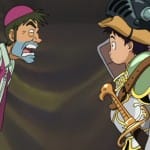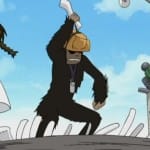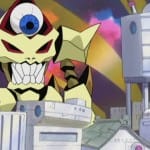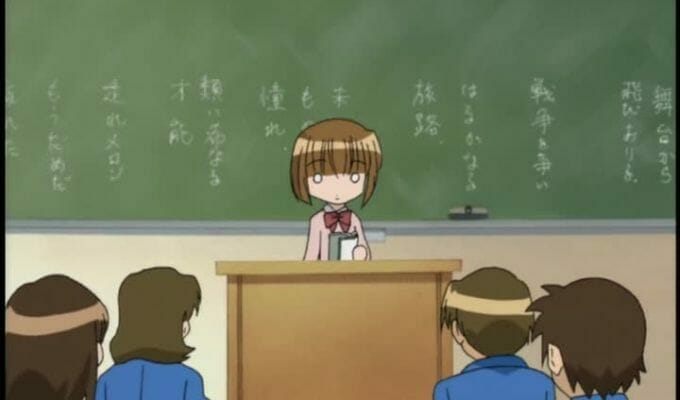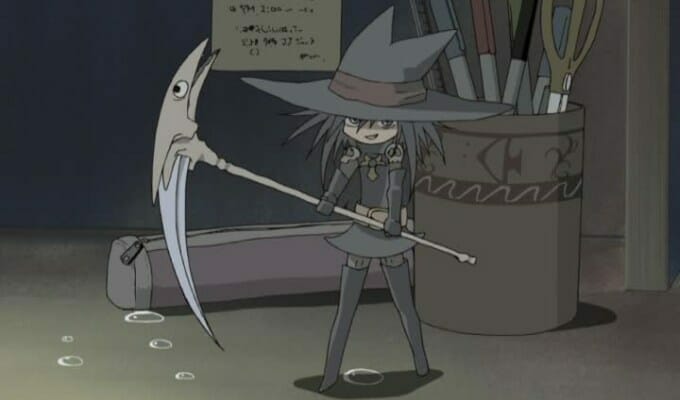What Is It?
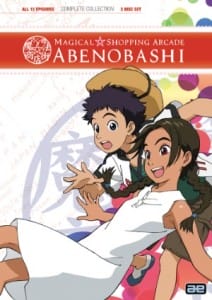 Magical Shopping Arcade Abenobashi is a 13-episode comedy series from Gainax.
Magical Shopping Arcade Abenobashi is a 13-episode comedy series from Gainax.
Yes, the same Gainax that gave the world Evangelion, and Gurren Lagann, and Panty & Stocking. The same Gainax that’s able to have viewers in peals of laughter at one moment, and gut-wrenching sorrow the next. That Gainax.
Where was I? Oh, right! Magical Shopping Arcade Abenobashi is set in Osaka’s Abenobashi Shopping Arcade. It’s here that Satoshi “Sasshi” Imamiya and his childhood friend Arumi Asahina were born and raised. Time is a cruel mistress, though. In its heyday, the arcade was a bustling marketplace, where families thrived and people traveled from miles to get their shop on.
Recently, though, Abenobashi is but a husk of its former self. Shops shutter with each passing day, as people seek a way to survive elsewhere. Sasshi’s family’s bath house was torn down, and Arumi’s family is making plans to move to Hokkaido, in hopes of landing better jobs.
Abenobashi isn’t a typical shopping center, though. Legends say that it was built on four points to invoke good fortune, with each point being marked by a special statue. When the final statue breaks, Sasshi and Arumi find themselves in a magical world, where everything is similar, but somehow totally different.
To get home, the two need to find their way through these alternate worlds, which range from lands of swords and sorcery, to film noir playgrounds, and even a realm of martial arts mayhem. All the while, they’ll need to avoid the crazies of each realm, as well as a strange bespectacled lass known only as “Mune Mune.” It’s an adventure of a lifetime, to say the least!
Why Was It Passed Up?
Magical Shopping Arcade Abenobashi first hit stores on December 16, 2003. In December 2003, no fewer than 63 anime titles hit store shelves, including heavyweights like Witch Hunter Robin, You’re Under Arrest, and Dragon Ball GT.
That gives us Strike 1 in the case of limited visibility.
On top of this, ADV had just finished its run of Excel Saga in April. For comedy shows, Excel Saga was pretty much hailed as the gold standard at the time. Fans raved about the quirky sense of humor and frenetic pace that just needed to be seen to be believed, while critics gushed over the show’s clever jokes and madcap action.
That’s strike 2: a perceived superior alternative on the market that has universal approval by the masses
The final strike, though, was the overall response in the critical community. While most of the reviews spoke highly of the show, they did caution that various references would leave a number of fans in the dust. On top of this, there was a general feeling that the format was done, and done better by other shows, like the recently completed Excel Saga.
And that was strike 3: The narrative stated that this was a poor man’s Excel Saga. And, frankly speaking, in a world where time and money are equally precious, why would one rush for the imitation when the real thing was out and available for purchase?
Sadly, this is another one of those shows that just didn’t have a chance in the market. It gained a cult following over the years, but it never really grew out of that small, devoted fanbase.
Why This Show?
Magical Shopping Arcade Abenobashi is a parody show that does so much right. It’s a series that’s able to tell a truly gut-wrenching tale of growing up, of facing the harsh realities of the world behind the veil of comedy. It’s a series that can make viewers erupt with laughter in one scene, only to jerk them into a stunned somber silence the next.
The show’s comedy is genuinely funny, with countless clever jabs, parodies, and references that will reach out to newcomers and long-time fans alike. At the same time, nothing is sacred. This is a show that will make Bruce Lee and Kill Bill jabs in one episode, and Evangelion spoofs the next, not to mention the sheer absurdity of the cast!
Seriously, look at this guy! (Editor’s note: Strong Language Warning)
It’s a show that knows exactly when to make light of itself, and pulls no punches when it does.
Abenobashi’s visual style is similarly wonderful, with each episode adopting a different motif to suit the theme of the world. In one episode, Sasshi could be putting on his best Kenshiro (From Fist of the North Star) impression, while the next would have him and Arumi rocking a realistic, toned-down style befitting of a 1920s gangster flick. The changes are often subtle, but they do a wonderful job of selling the various situations that the two leads find themselves in.
Closing Thoughts
It was only a matter of time before I made a recommendation for Abenobashi. It’s a show that was released early in the bubble years, to a crowded market that was tired of the parody game thanks to Excel Saga. It really didn’t have much of a chance to find a real audience, which is a crying shame.
Magical Arcade Abenobashi is an amazing comedy show, that weaves a surprisingly sophisticated and mature story through its countless gags and silly references. It’s a smart show, that may have gone a bit too far to make its narrative subtle, that most saw it as yet another gag show.
It’s a shame, really, because this is a show that’s loaded with personality. The characters, from the aging transvestite to Mune Mune, are lively and memorable, with their own eccentricities and habits that will stick with the viewer. The worlds themselves are colorful and bright, with enough similarities to tie each episode together, while ensuring that no two places look the same.
And, really, it’s just a truly fun experience. It’s a show that will mislead and misdirect, tease and taunt viewers its entire run, for a payoff that’s simply incredible. It’s a true diamond in the rough, that deserves to be discovered.










